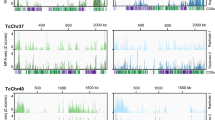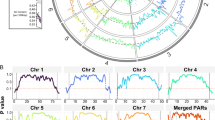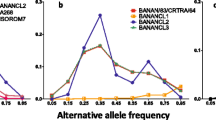Abstract
The chromosomes of many protozoans are polymorphic in size, but African trypanosomes contain diploid homologues which are exceptionally size-polymorphic. We present the first complete analysis of the structure of a Trypanosoma brucei megabase chromosome which reveals the concentration of repetitive sequence, non-random distribution of transposon-like elements, and a hemizygous variant surface glycoprotein gene expression site. Subsequent comparative analyses of size-polymorphic homologues show that the repetitive regions are highly polymorphic, as demonstrated in studies on the chromosomes of other protozoan parasites. We show that a large number of the transposon-like elements are located in these regions. However, although we have shown elsewhere that synteny is maintained in coding regions, homologous chromosomes may vary along their entire length. Thus, the variable chromosomal location of variant surface glycoprotein expression gene sites, the expansion and contraction of repetitive DNA, the number of putative transposons, sequence polymorphism at chromosome ends, and expansion and contraction within or between coding regions all contribute to huge chromosomal size polymorphisms in T. brucei.
Similar content being viewed by others
References
Adam RD (1992) Chromosome size variation in Giardia lamblia: the role of rDNA repeats. Nucl Acids Res 20: 3057-3061.
Affolter ML, Rindisbacher L, Braun R (1989) The tubulin gene cluster of Trypanosoma brucei starts with an intact beta-gene and ends with a truncated beta-gene interrupted by a retrotransposon-like sequence. Gene 80: 177-183.
Barry JD, Graham SV, Fotheringham MV, Graham VS, Kobryn K, Wymer B (1998). VSG gene control and infectivity strategy of metacyclic stage Trypanosoma brucei. Mol Biochem Parasitol 91: 93-105.
Beals TP, Boothroyd JC (1992) Genomic organization and context of a trypanosome variant surface glycoprotein gene family. J Mol Biol 225: 961-971.
Blackburn EH, Challoner PB (1984) Identification of a telomeric DNA sequence in Trypanosoma brucei. Cell 36: 447-457.
Brun R, Schonenberger M (1979) Cultivation and in vitro cloning of procyclic culture forms of Trypanosoma brucei in semi-defined medium. Acta Tropica 36: 289-292.
Campbell DA, van Bree MP, Boothroyd JC (1983) The 5′-limit of transposition and upstream barren region of a trypanosome VSG gene: tandem 76-bp repeats flanking (TAA)90. Nucl Acids Res 12: 2759-2774.
Carmena M, Gonzalez C (1995) Transposable elements map in a conserved pattern of distribution extending from beta-heterochromatin to centromeres in Drosophila. Chromosoma 103: 676-684.
Carrington M, Miller N, Blum M, Roditi I, Wiley D, Turner M (1991) Variant specific glycoprotein of Trypanosoma brucei consists of two domains each having an independently conserved pattern of cysteine residues. J Mol Biol 221: 823-835.
Cross GAM (1996) Antigenic variation in trypanosomes: secrets surface slowly. Bioessays 18: 283-291.
Cully DF, Ip HS, Cross GAM (1985) Co-ordinate transcription of variant surface glycoprotein genes and an expression site associated gene family in Trypanosoma brucei. Cell 42: 173-182.
de Bruin D, Lanzer M, Ravetch JV (1994) The polymorphic subtelomeric regions of Plasmodium falciparum chromosomes contain arrays of repetitive sequence elements. Proc Natl Acad Sci USA 91: 619-623.
Gibson WC, Garside L (1991) Genetic exchange in Trypanosoma brucei: variable location of housekeeping genes in different trypanosome stocks. Mol Biochem Parasitol 45: 77-90.
Gottesdiener KJ, Garcia-Anoveros M, Lee MGS, van der Ploeg LHT (1990) Chromosome organization of the protozoan Trypanosoma brucei. Mol Cell Biol 10: 6079-6083.
Hasan G, Turner MJ, Cordingley JS (1984) Complete nucleotide sequence of an unusual mobile element from Trypanosoma brucei. Cell 37: 333-341.
Henriksson J, Procel B, Rydaker M et al. (1995) Trypanosoma cruzi genome project: chromosome-specific markers reveal conserved linkage groups in spite of extensive chromosomal size variation. Mol Biochem Parasitol 73: 63-74.
Johnson PJ, Borst P (1986) Mapping of VSG genes on large expression-site chromosomes of Trypanosoma brucei separated by pulsed-field gradient electrophoresis. Gene 43: 213-20.
Kemp DJ, Corcoran LM, Coppel RL et al. (1985) Size variations in chromosomes from independent cultured isolates of Plasmodium falciparum. Nature 315: 347-350.
Kimmel BE, ole-Moiyoi OK, Young JR (1987) Ingi, a 5.2 kb dispersed sequence element from Trypanosoma brucei that carries half of a smaller mobile element at either end and has homology with mammalian LINEs. Mol Cell Biol 7: 1465-1475.
Kooter JM, van der Spek HJ, Wagter R et al. (1987) The anatomy and transcription of a telomeric expression site for variant-specific surface antigens in T. brucei. Cell 51: 261-272.
Lanzer M, de Bruin D, Ravetch JV (1993) Transcriptional differences in polymorphic and conserved domains of a complete cloned P. falciparum chromosome. Nature 361: 654-657.
Marchand M, Kooystra U, Wierenga RK et al. (1989) Glucose-phosphate isomerase from Trypanosoma brucei. Eur J Biochem 184: 455-464.
Matthews KR, Shiels PG, Graham SV, Cowan C, Barry JD (1990) Duplicative activiation mechanisms of two trypanosome telomeric VSG genes with structurally simple 5′ flanks. Nucl Acids Res 18: 7219-7227.
Melville SE, Shepherd NS, Gerrard CS, Le Page RWF (1996) Selection of chromosome-specific DNA clones from African trypanosome genomic libraries. In: Birren B, Lai E, eds. Analysis of Non-Mammalian Genomes. New York: Academic Press, pp 257-293.
Melville SE, Leech V, Gerrard CS, Tait A, Blackwell JM (1998) The molecular karyotype of the housekeeping chromosomes of Trypanosoma brucei and the assignment of chromosome markers. Mol Biochem Parasitol 94: 155-173.
Navarro M, Cross GAM (1996) DNA rearrangements associated with multiple consecutive directed antigenic switches in Trypanosoma brucei. Mol Cell Biol 16: 3615-3625.
Osinga KA, Swinkels BW, Gibson WC et al. (1985) Topogenesis of microbody enzymes: a sequence comparison of the genes for glycosomal (microbody) and cytosolic phosphoglycerate kinases of Trypanosoma brucei. EMBO J 4: 3811-3817.
Pays E, Tebabi P, Pays A et al. (1989) The genes and transcripts of an antigen gene expression site from T. brucei. Cell 57: 835-845.
Pierce JC, Sternberg N (1993) Using the bacteriophage P1 system to clone high molecular weight genomic DNA. Meth Enzymol. 216: 549-574.
Pimpinelli S, Berloco M, Fanti L et al. (1995) Transposable elements are stable structural components of Drosophila melanogaster heterochromatin. Proc Natl Acad Sci USA 92: 3804-3808.
Ravel C, Wincker P, Blaineau C, Britto C, Bastien P, Pages M (1996) Medium-range restriction maps of five chromosomes of Leishmania infantum and localization of size variable regions. Genomics 35: 509-516.
Rudenko G, Blundell PA, Dirks-Mulder A, Kieft R, Borst P (1995) A ribosomal promoter replacing the promoter of a telomeric VSG gene expression site can be efficiently switched on and off in T. brucei. Cell 83: 547-553.
Tait A, Buchanan N, Hide G, Turner CMR (1993) Genetic recombination and karyotype inheritance in Trypanosoma brucei species. In: (Ed. Morzaria S), Genome Analysis of Protozoan Parasites. Nairobi, ILRAD Press: pp 93-108.
Tait A, Buchanan N, Hide G, Turner CMR (1996) Self-fertilisation in Trypanosoma brucei. Mol Biochem Parasitol 76: 31-42.
Thomashow LS, Milhausen M, Rutter WJ, Agabian N (1983) Tubulin genes are tandemly linked and clustered in the genome of Trypanosoma brucei. Cell 32: 35-43.
Tschudi C, Ullu E (1988) Polygene transcripts are precursors to calmodulin mRNAs in trypanosomes. EMBO J 7: 455-463.
Turner CMR, Sternberg J, Smith E, Buchanan N, Hide G, Tait A (1990) Evidence that the mechanism of gene exchange in Trypanosoma brucei involves meiosis and syngamy. Parasitology 101: 377-386.
Turner CMR, Melville SE, Tait A (1997) A proposal for karyotype nomenclature in T. brucei. Parasitol Today 13: 5-6.
Van der Ploeg LHT, Valerio D, de Lange T, Bernards A, Borst P, Grosveld FG (1982) An analysis of cosmid clones of nuclear DNA from Trypanosoma brucei shows that the genes for variant surface glycoproteins are clustered in the genome. Nucl Acids Res 10: 5905-5923.
Van der Ploeg LHT, Cornelissen AWCA, Barry JD, Borst P (1984) Chromosomes of kinetoplastida. EMBO J 3: 3109-3115.
Weiden M, Osheim YN, Beyer AL, Van der Ploeg LH (1991) Chromosome structure: DNA nucleotide sequence elements of a subset of the minichromosomes of the protozoan Trypanosoma brucei. Mol Cell Biol 11: 3823-34.
Wesley CS, Myers MP, Young MW (1994) Rapid sequential walking from termini of cosmid, P1 and YAC vectors. Nucl Acids Res 22: 538-539.
Wincker P, Ravel C, Blaineau C et al. (1996) The Leishmania genome comprises 36 chromosomes conserved across widely divergent pathogenic species. Nucl Acids Res 24: 1688-1694.
Zomerdijk JCBM, Ouellette M, ten Asbroek ALMA et al. (1990) The promoter for a variant surface glycoprotein gene expression site in Trypanosoma brucei. EMBO J 9: 2791-2801.
Author information
Authors and Affiliations
Rights and permissions
About this article
Cite this article
Melville, S.E., Gerrard, C.S. & Blackwell, J.M. Multiple Causes of Size Variation in the Diploid Megabase Chromosomes of African Trypanosomes. Chromosome Res 7, 191–203 (1999). https://doi.org/10.1023/A:1009247315947
Issue Date:
DOI: https://doi.org/10.1023/A:1009247315947




